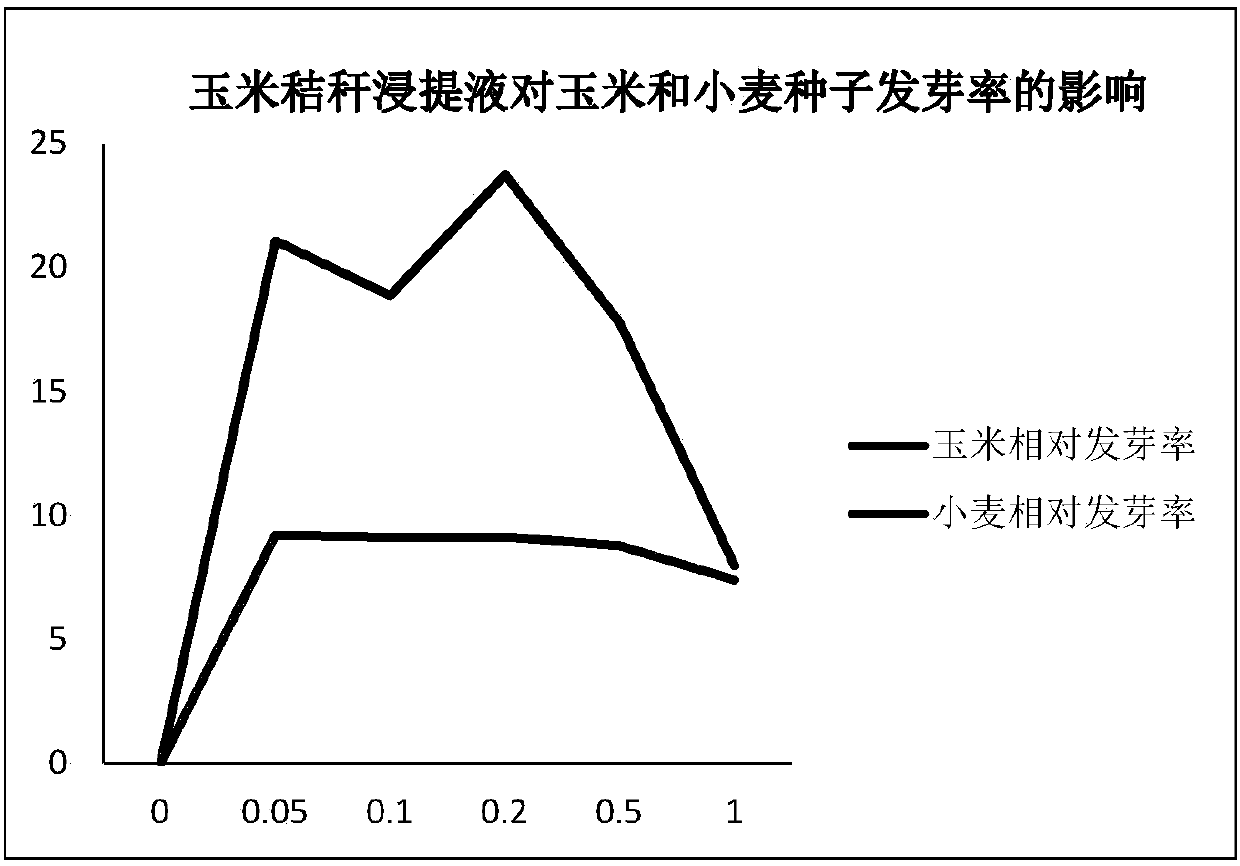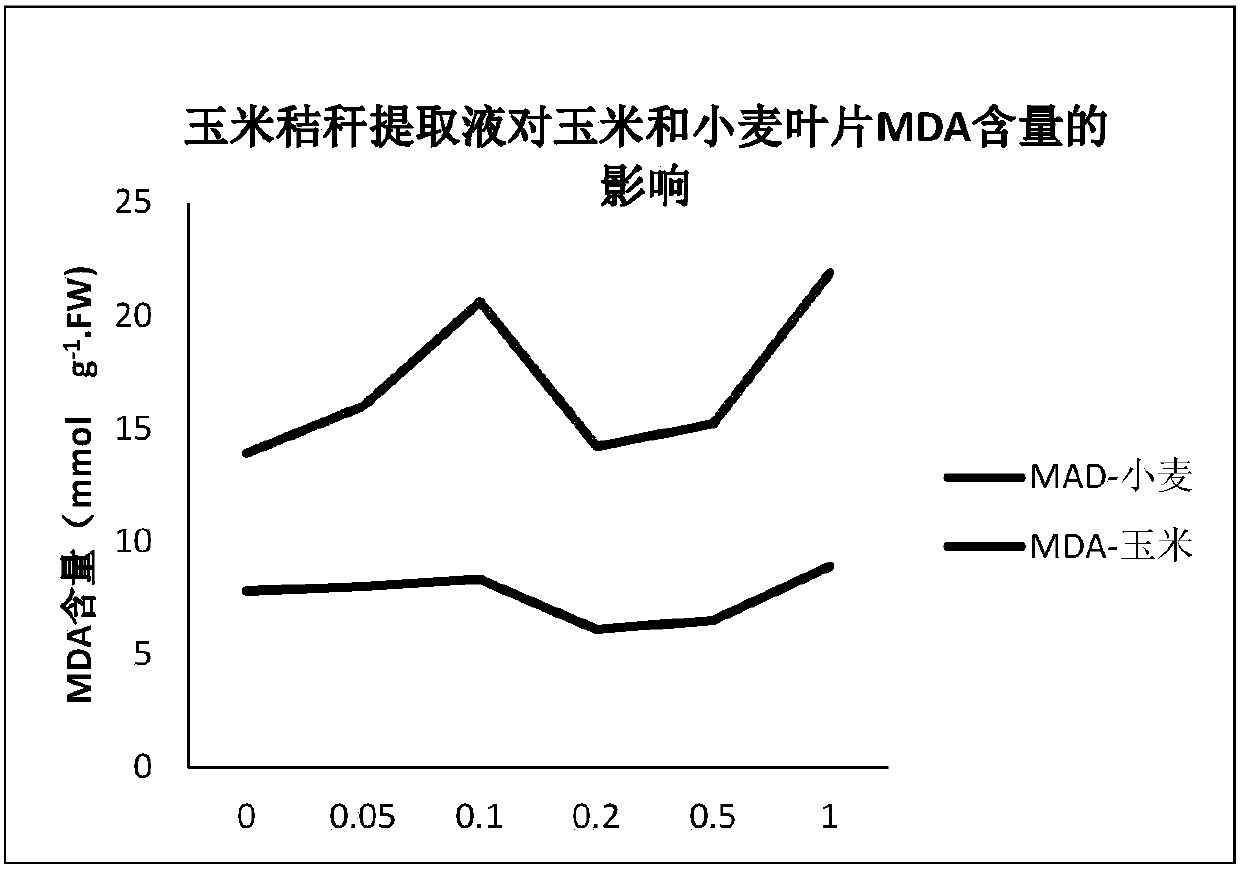Method for increasing utilization rate of nutrient elements after straw returning to field
A nutrient element and straw technology, applied in the field of soil improvement, can solve the problems of increasing farmers' planting costs, water pollution, and loss of excess nutrients
- Summary
- Abstract
- Description
- Claims
- Application Information
AI Technical Summary
Problems solved by technology
Method used
Image
Examples
Embodiment 1
[0032] Example 1 Effect of corn stalk extract on germination and seedling growth of corn and wheat
[0033] 1.1 Test method
[0034] Preparation of corn stalk extract: Cut the leafy corn stalks into 1-3cm sections after natural air-drying, weigh 2kg in a container, add 20L distilled water, soak at 37 degrees Celsius for 48h, filter and place in a rotary evaporator in batches Evaporate and concentrate to 2L to obtain 1g·DW / m1 solution, then dilute respectively to obtain 0.05, 0.1, 0.2, 0.5, 1g·DW / ml extracts for later use.
[0035] Crop seed germination test treatment: commercially available corn and wheat seeds were used as test materials, 1200 plump and active seeds were selected, and sterilized with 1% potassium permanganate solution. Randomly divided into 6 groups. Each treatment was repeated 4 times. Select 50 grains of corn and wheat seeds each in a petri dish with two layers of filter paper, add 15m1 of 0.05, 0.1, 0.2, 0.5, 1g·DW / ml straw extract to each petri dish, a...
Embodiment 2
[0041] Example 2 Optimization and detection of straw decomposing bacteria agent
[0042] 2.1 Preparation of straw decomposed compound bacterial agent
[0043] Types of bacteria
The proportion of bacteria (mass ratio)
Trichoderma Reesei
10-20%
Aspergillus oryzae
3-15%
5-20%
White Rot Fungus (Phanerochaete Chrysosprium)
10-20%
15-20%
Clostridium cellulovorans
10-20%
Sporocytophaga
3-10%
10-20%
5-15%
5-15%
[0044] The total effective number of viable bacteria of the above-mentioned straw decomposing composite bacterial agent is 1-2×10 8 individual / mL.
[0045] The above-mentioned straw decomposing composite bacterial agent contains bacteria, fungi and actinomycetes, which overcomes the problem of limited ability of a single microorganism to decompose macromolecular substances with com...
Embodiment 3
[0054] Example 3 Effect of Straw Returning on Soil Fertility Using Straw Decomposition Compound Bacteria Agent
[0055] Corn and wheat rotations are mostly used in agricultural planting, so the typical corn-wheat rotation system was taken as the research object to determine the effect of straw decomposing compound bacterial agent on soil fertility and wheat fertilization after corn straw was returned to the field.
[0056] 3.1 Test grouping
[0057] There were 5 treatments in the field experiment, and each treatment was repeated 3 times. The method of returning straw to the field is to return part of the straw to the field through crushing. The traditional fertilization without straw returning was set as the control group (CK group), and the other 4 groups included: simple corn straw returning to the field + traditional fertilization group (Group A), corn straw returning to the field + corn straw decomposed compound microbial agent group (Group B) ), corn stalk returning to ...
PUM
 Login to View More
Login to View More Abstract
Description
Claims
Application Information
 Login to View More
Login to View More - R&D
- Intellectual Property
- Life Sciences
- Materials
- Tech Scout
- Unparalleled Data Quality
- Higher Quality Content
- 60% Fewer Hallucinations
Browse by: Latest US Patents, China's latest patents, Technical Efficacy Thesaurus, Application Domain, Technology Topic, Popular Technical Reports.
© 2025 PatSnap. All rights reserved.Legal|Privacy policy|Modern Slavery Act Transparency Statement|Sitemap|About US| Contact US: help@patsnap.com


